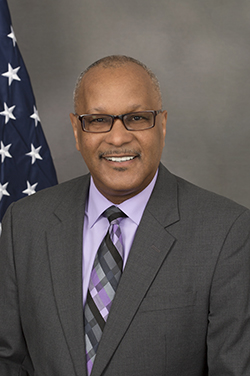
Edwin L. Walker is Deputy Assistant Secretary for Aging of the Administration on Aging (AoA) within the Administration for Community Living. As he says, he “focuses on all things aging: policy, program development, research,” but mostly he listens to older people, hears the most critical issues and responds to their concerns. Walker ensures that the national aging services network is responsive to older adult needs and meets the goals put forth in the Older Americans Act.
Previous to joining the AoA, Walker directed the Missouri Division of Aging. He has a Juris Doctorate from the University of Missouri-Columbia School of Law and a Bachelor’s Degree in Mass Media Arts from Hampton University.
Generations Now (GN): How might you describe the way leadership in the field of aging differs from leadership in other fields?
Edwin L. Walker (EW): Leadership in the field of aging is filled with a high degree of dedication. It is filled with hands-on doing, and is inclusive of staff work, not just management. There may not be an abundance of people and staff resources, but there is a huge mission, and a clear sense of what needs to be done.
People at all levels just jump in. They are focused on the specific needs of older people, and, in the aging sector leaders need to be broader, they need to incorporate the general principles of leadership from other fields in order to be most effective. Otherwise, we would never get ahead of the crisis or issues we are facing. To be truly successful, we must step above dealing with immediate issues or crises.
GN: How did you use networking to progress in the field of aging?
EW: Networking is critical because progress cannot be made without it. No one person is an island; no one has all the perspectives. It takes broad input of different perspectives, and other entities can add what you need to help you to complete and fulfill the mission. Networking is a character trait that has allowed me to be successful.
One of the best things in the field of aging in terms of leadership and networking was an AoA-funded National Leadership Institute on Aging started in the mid- to late-80s, which ran through the mid-90s. The added value was that it solely focused on leadership in field of aging. Led by [the late] Dail Neugarten from the University of Colorado at Denver, it was a residential program in Estes Park, Colorado. This meant participants were away from their offices, away from their daily routines and daily crises. It was a real retreat from the rest of world. The curriculum was based on evidence, case studies, leadership principles and the science of leadership, all as they applied to issues of the aging network. It permitted us to focus on real issues in the field of aging. It built a sense of collegiality. We made partnerships and alliances, which we called upon well after the course was done. I remember all the people in my class, and we related to and supported each other for years and decades afterward.
GN: What sort of education did you find most helpful?
EW: I was a mass communications undergrad, which gave me good grounding in effective communications, both orally and in writing. Law school just honed that. It provided an array of universal, transferable skills, such as how to analyze, how to communicate persuasively, to listen carefully, and to be open to a variety of perspectives. Law school teaches that there’s never just one right answer. Each side thinks their position is valid. As I went into the public/governmental sector, learning administrative procedures and law, and policy-making were critical. I never practiced law, but I was able to avoid litigation in my career by incorporating all the things I had learned, how to not create something discriminatory, and take care of the mission of the organization at the same time.
GN: What do you think is the most critical skill to have as a leader?
EW: It’s a combination of flexibility, listening carefully, being and staying grounded in the mission. Above all is to be credible and genuine. I used to teach this law and aging seminar at Howard University Law School, to second- and third-year students. Law school programs people to practice law, but with the transferable skills learned, I encouraged students that they could do anything. First know yourself, be credible, be genuine and be truthful. That’s what causes others to follow you, because they believe in you.
GN: Can you speak to one leadership challenge encountered on the job and how you met it?
EW: My most significant accomplishment (because the challenge was so great and embedded in policy), was back in Missouri. I had sensed what consumers want, what their preferences were, and it had become clear that older people preferred to stay in their own homes. Yet, public policy at the federal level at that time and at the state level as it related to Medicaid was to give preference to institutional care. One automatically became eligible for placement in a nursing home. If you wanted to stay home with care, the state had to apply for a waiver.
And there was a powerful nursing home lobby. Many state legislators had conflicts of interest as they owned nursing homes. I met with every industry that impacted the field of aging. I clearly heard and saw, in the allocation of resources, that the nursing home folks always got rate increases, but we couldn’t get the same on the homecare side. I likened it to a pie with a finite number of pieces and their slice always got larger. I felt that was unfair, and just inconsistent with what people wanted.
So, I embarked upon a huge coalition-building exercise. I needed to have more than passion and a knowledge of older adults’ preferences. I sought out the University of Missouri Center on Aging Studies for their research, to have a grounding in research, science, data, to prove my point, then I built a broad coalition of stakeholders to focus on what was needed in the state regarding the future of aging.
After reviewing the data, trends, and preferences, each stakeholder at the table got one vote. In this way, the influence of the nursing home industry was balanced, and we built a credible plan that served as the basis for advocacy. We presented it to the general assembly for consideration, and I was direct and brutal with the stakeholders and advocates representing aging and disability. I set advocacy criteria (which would never fly now) because I needed a visual representation of those who benefitted from our programs. I said, “If you don’t have gray hair or if you’re not in a wheelchair, I don’t need you in these hearing rooms.” I wanted legislators to be confronted with the faces of the people, so they would not ignore who they were supposed to represent.
The result was wonderful. We completely flipped the policy, rebalancing long-term-care in the state, and received the largest budget increase for home- and community-based services.
GN: What might you say to inspire younger potential leaders in the aging sector?
EW: First I would introduce them to the aging sector. Because they’re never thinking about aging or the public sector, and it is a noble field. It will provide such significance and purpose to their lives. That’s what has motivated me throughout my career.
The field is filled with dedicated professionals who could go elsewhere and make more money. But it’s not about the money, it’s about being in tune with a mission and knowing that it means something to do this work. I’ve always been proud to be a part of it. As I say in speeches, ‘aging was not my plan, but it has become my passion.’ It’s a field I fell into and then I fell in love with. I feel destined to do this work. I encourage young people by asking them to check their hearts, think about all the things they could do and ask if aging is it.
Editor’s note: This past January, ASA surveyed its members about what it takes to be a leader in the field of aging, what members would like to learn about how to develop leadership knowledge, skills and abilities, and who best personifies leadership. ASA members identified respected leaders in aging—many of whom are well known to the ASA community and to the field at large. This following Q&A with Edwin L. Walker is one in a series of leadership profiles we will feature on ASA’s Generations Now blog













